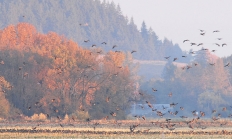Article
Private lands accounts for just over half of Oregon’s land base and include farms, range lands, wetlands, forests and stream corridors. To improve landowner-hunter relations and engage landowners in the conservation of fish and wildlife, the Oregon Legislature created the Access & Habitat (A&H) Program in 1993. The law established a funding mechanism to provide grants to private landowners, timber and agriculture corporations, sportsmen groups, natural resource agencies, and others for projects designed to increase public hunting access to private lands and/or improve wildlife habitat.
April 19, 2023








